
Rebecca Cohen
About the Author
Rebecca Cohen is an aspiring investment analyst and financial historian with over 15 years of hands-on experience in numismatic art. From the very beginning, her focus on coins was motivated by a deep fascination with how history, art, and economics get merged in tiny, artful objects that have traveled through time and hands. As a result, she co-founded a boutique advisory firm specializing in rare coin investments and historical asset analysis, without which collecting might be crippling.
Cohen’s expertise was quite naturally supported by the solid academic foundation. Having completed programs at the University of Pennsylvania and the Wharton School, she earned her Master’s degree in Finance and holds several professional certifications from the American Numismatic Association.
To share her experience with her potential clients and investors (be they professional or amateur), Rebecca regularly contributes to Forbes, Barron’s, and Coin World to present the latest financial analysis and historical insights altogether. And today, we are pleased to present her profound research on the super rare 1943 steel penny value today – the appearance, context, and what makes it unique. Enjoy!
Follow Rebecca on Social Media



Why the Steel Penny 1943 Value Still Delights
Wars create memories – of bravery, betrayal, cruelty, and love. The moments that have been gone for decades often leave behind small, unexpected traces, and these might be not only metaphorical but literal, physically present. One such relic that instantly takes us back to the time when nations all over the world had to fight against evil is the 1943 steel penny.
During this experimental year, 1-cent coins were accidentally minted in two compositions, i.e., the classic copper (which was diverted to ammunition from then on) and the new steel. Although it might be only about the events and circumstances they had been brought by, the era these numismatic creations represent boosts the value 1943 steel penny for good.
But how much do they cost for modern coin collectors? Why exactly are they so special? And what should one do to identify a genuine penny after all?
| The Main Characteristics of the 1943 Cent | |
| Composition | Zinc-coated steel, i.e., low-grade carbon steel with zinc plating |
| Weight | 2.70 grams |
| Diameter | 19.05 mm |
| Thickness | 1.55 mm |
| Edge | Plain (no reeding) |
| Color/Appearance | Silver-gray, may get darker or spotted with age |
| Mint Marks | None for Philadelphia“D” for Denver“S” for San Francisco |
| Obverse Design | A right-facing Abraham Lincoln with the inscriptions “IN GOD WE TRUST” above, “LIBERTY” on the left, and the date “1943” (plus mintmark if present) to the right of the profile |
| Reverse Design | Two wheat ears framing the words “ONE CENT”, “UNITED STATES OF AMERICA”, and “E PLURIBUS UNUM” at the top. |
1943 Cent Varieties by Mint
1943 1C
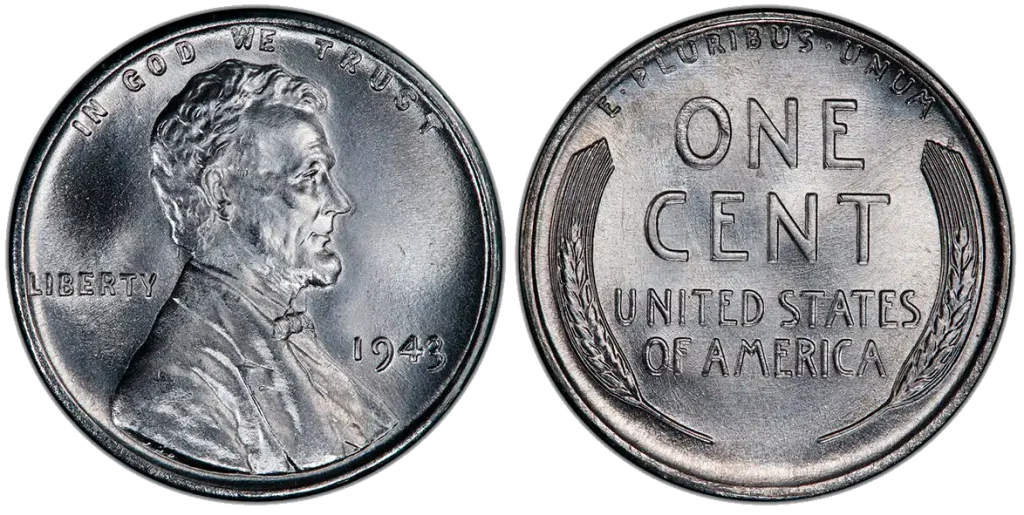
- Produced by: Philadelphia Mint
- Mintage: 684,628,670
- Auction Record: $218,500 for AU58
Being a part of a wartime strategy to conserve copper for military use, the US Mint introduced a new steel Lincoln cent. The Philadelphia Mint met this initiative with the highest production of the three facilities that year (in fact, nearly triple that of Denver and San Francisco). What is unique is that these cents are common in circulated condition but can carry significant 1943 steel penny value no mint mark at higher grades.
1943-D 1C
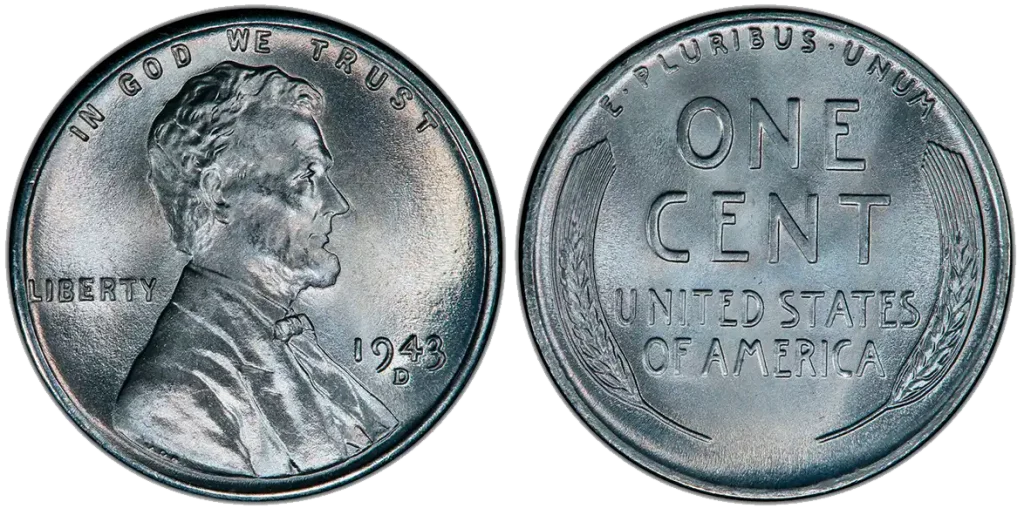
- Produced by: Denver Mint
- Mintage: 217,660,000
- Auction Record: $14,400 for MS68+
The Denver Mint, on its part, was responsible for one more type of coin that remains widely available, particularly in circulated and mid-grade uncirculated condition. According to PCGS, Mint State samples found on the market are abundant and can be sold in separate packaging, and top-tier instances in MS68+ are worth more. This is why the 1943 D steel penny value today is unstable and may dramatically vary from grade to grade.
1943-S 1C
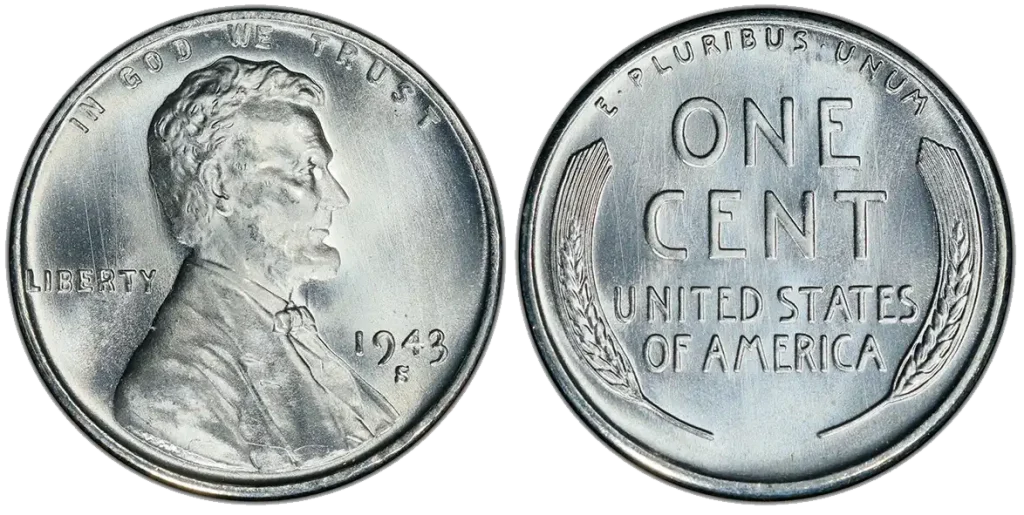
- Produced by: San Francisco Mint
- Mintage: 191,550,000
- Auction Record: $138,000 for AU58
Here is the last instance in the 1943 line, which may boast a decent 1943 S steel penny value. As a rule, the San Francisco Mint is usually responsible for proof coins; this time, things differ. In 1943, there were released only prooflike cents that managed to be well preserved (with high grades being not uncommon). However, coins that survive in MS68 are much harder to come by, giving them a special place in high-end collections either way.
What’s the Value of a 1943 Steel Penny?
Although the 1943 penny value steel has never been stable, its uniqueness cannot be denied. All in all, it is mainly about external factors that may set the path for the pricing trends and appeal in general. But what are they?
Factors Affecting 1943 Lincoln Steel Penny Value
- Mint Mark: The mint of origin can significantly influence how much a coin costs. Philadelphia coins are typically the most common, while Denver (D) and especially San Francisco (S) instances can be worth more in high grades.
- Condition (Grade): Coin grading ranges from heavily worn (Good) to near-perfect (Mint State) condition. Even the slightest alterations in the appearance can change the market steel 1943 penny value at once.
- Luster and Appeal: Coins that retain original mint luster, have clean surfaces, and minimal signs of wear are more desirable to collectors and, hence, are usually worth more than their less flawless counterparts.
Knowing that different aspects may influence the worth, it is vital to acknowledge the main price ranges offered by reputable numismatic resources like PCGS. So, what is the value of a 1943 steel penny?
| Grade | Philadelphia | Denver | San Francisco |
| Good (G-4) | $0.10 – $0.20 | $0.15 – $0.30 | $0.20 – $0.40 |
| Fine (F-12) | $0.20 – $0.40 | $0.25 – $0.50 | $0.30 – $0.60 |
| Extremely Fine (EF-40) | $0.40 – $0.75 | $0.50 – $1.00 | $0.60 – $1.25 |
| About Uncirculated (AU-50) | $0.75 – $16 | $1.00 – $12 | $1.25 – $15 |
| Mint State (MS-63) | $22 – $24 | $22 – $24 | $22 – $24 |
| Mint State (MS-65) | $30 – $37 | $30 – $37 | $40 – $50 |
| Premium (MS-67) | $575+ | $525+ | $625+ |
Mind that auction records often reflect significantly higher prices than the typical market worth. This is because auctions can create competitive bidding environments driven by rarity, collector excitement, and buyer emotion.
Rare & Valuable 1943 Steel Penny Errors
1943 Bronze Penny (Ultra-Rare Error)
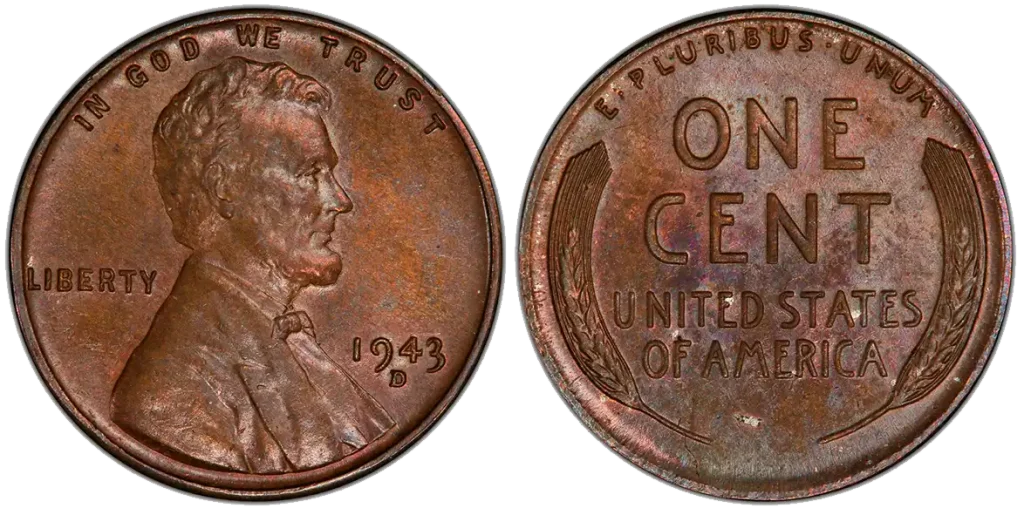
Estimated Value: Up to $840,000 (MS64BN)
When the production started, some processes might have been mixed up because of the experimental composition having been imposed. This led to a quite natural situation: a few copper (bronze) planchets from previous years were utilized, resulting in one of the most famous US coin errors to exist. What is more, this happened at all three mints during the transition year, which is why one may observe bronze creations with “D”, “S”, or no mint mark at all.
When compared to a regular 1943-D steel penny value, the one that refers to its bronze counterpart is far more impressive!
1943-D/D Repunched Mint Mark
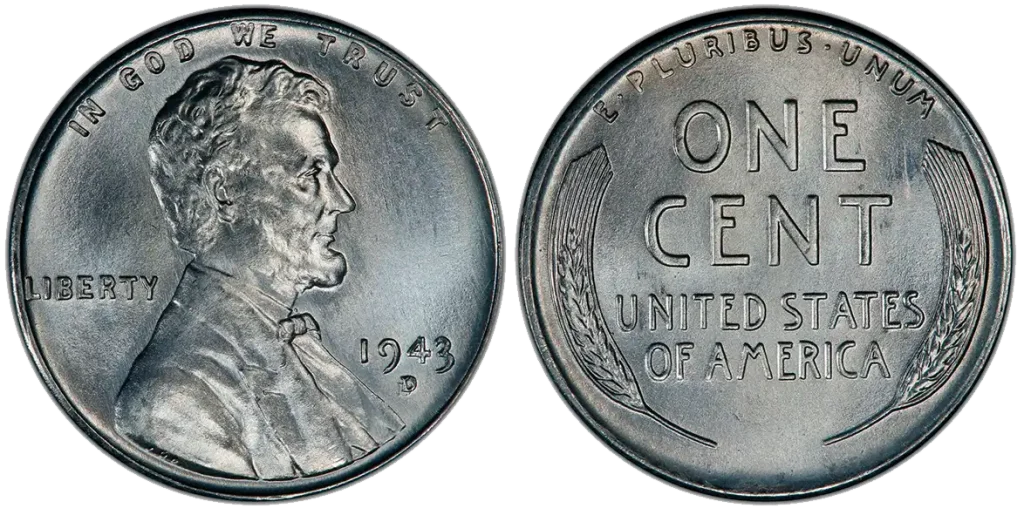
Estimated Value: Up to $21,275 (MS67)
When it comes to other notable deviations, one may take a look at repunched mint marks, especially D/D ones. This means that the original punch was struck twice, slightly off-angle. In fact, auctions dazzle with numerous variations of the same coin, yet with different severities and price levels.
1943 Doubled Die Obverse (DDO)
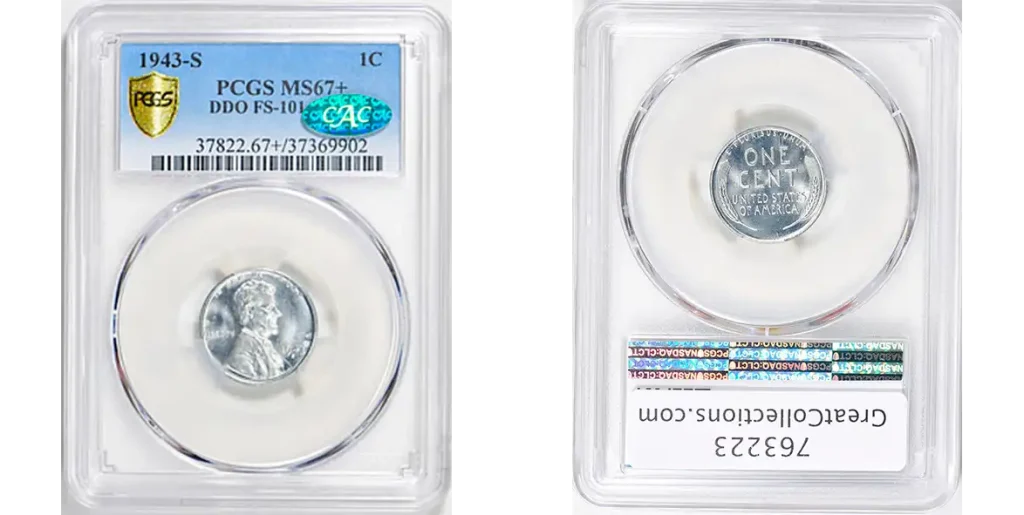
Estimated Value: $1,500+
Here comes the most widespread error, which might be found on every coin type for sure. In this particular case, instances with such an error display visible doubling on the obverse inscriptions, especially on “LIBERTY” or the date. The source of the doubling effect is rather simple: this happens during die production when the die receives a second misaligned impression from the hub, causing doubled images on the struck coins.
1943 Doubled Die Reverse (DDR)
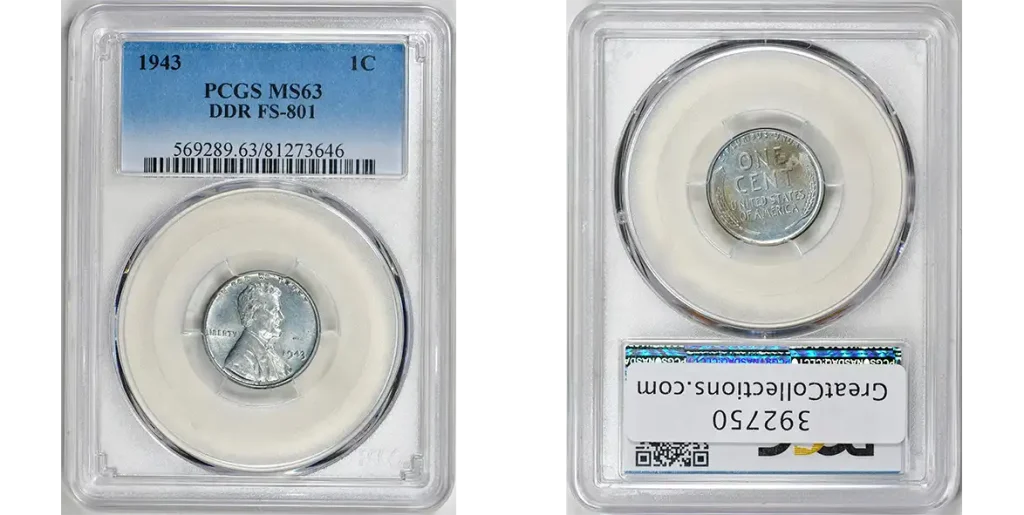
Estimated Value: $1,200+
Just like the Doubled Die Obverse, the same error found on the reverse side demonstrates doubling on elements like “ONE CENT” or “UNITED STATES OF AMERICA”, which is a bit more complicated to spot but still alluring to store.
How to Identify a Valuable 1943 Steel Penny
Should you wish to check the 1943 wheat penny value steel, it is essential to ensure which coin you own. Here is a step-by-step guide to help you determine the type of numismatic creation in your collection. Remember: the 1943-s steel penny value is high, and detecting it as soon as possible may bring you wealth one day.
- Check the Mint Mark
The mint mark indicates the origin of a coin and can significantly affect its worth. Take a look just below the date on the obverse side of the coin:
- No mint mark – Struck at the Philadelphia Mint, the most common variety.
- “D” mint mark – Struck at the Denver Mint, more collectible in high grades.
- “S” mint mark – Struck at the San Francisco Mint, usually the most valuable among the standard issues..
With the help of the mint marks, collectors may also identify rare varieties like repunched marks (RPMs), which can increase the 1943 P steel penny value, for instance, dramatically.
- Test with a Magnet
A quick magnet test can reveal a lot:
- Steel cents will stick to a magnet thanks to the presence of their iron core.
- If the coin does not stick, this may refer to either the ultra-rare 1943 bronze/copper errors or a counterfeit.
Defining the origin of the instance via more advanced testing after this is a must!
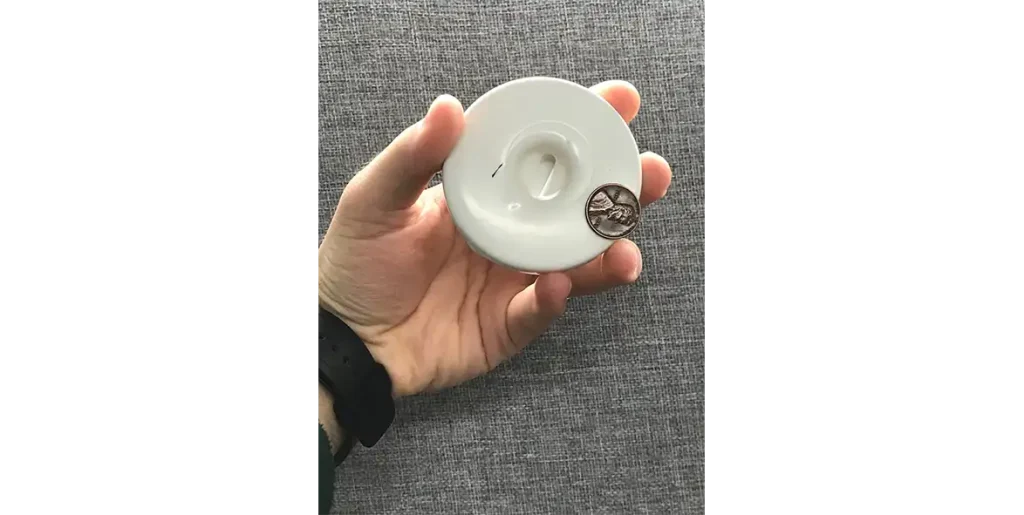
- Look for Errors
As we have covered before, the 1943 steel penny no mint mark value can be boosted via errors present on it. Apart from those mentioned above, one should also pay attention to off-center strikes, wrong planchet errors, broad strikes, strikethroughs, and even more.
Always use a magnifying glass or coin loupe to spot these features in detail.
- Evaluate the Condition (Grade)
The physical state the coin is to display is one of the most critical factors in determining the worth.
- Uncirculated (MS-60 to MS-70): No wear, full mint luster, and strong strike details. The highest prices.
- About Uncirculated (AU-50 to AU-58): Minimal wear on high points, with most luster intact.
- Circulated (G–VF): Moderate to heavy wear. The most common and lower in value.
Professional grading by services like PCGS or NGC may uplift the 1943 no mint steel penny value, but this requires time and money to perform.
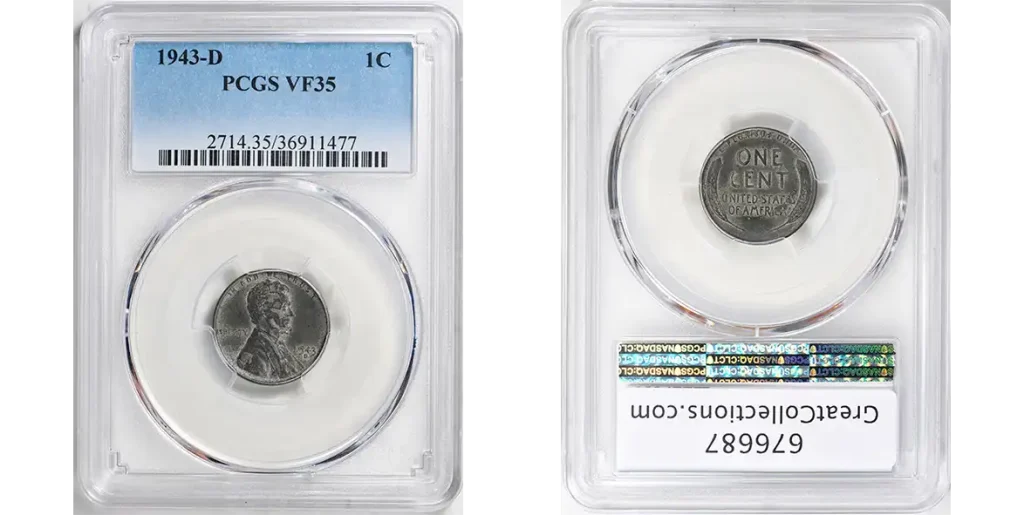
- Use Digital Identification Tools
Last but not least, one is always free to appeal to external identification tools to detect what type of coin they have in an instant:
- Besides, these can identify mint marks, dates, and varieties, and provide collectors’ insights based on the current situation on the market.
- Coin ID apps (like Coin ID Scanner, CoinSnap, PCGS CoinFacts, or Coinoscope) allow one to photograph their coin and get instant matches from databases. Besides, these may spot errors and provide extensive 1943 D steel wheat penny value explanations when needed.
FAQs
Why is the 1943 D penny value steel higher?
Although numismatic creations of this kind are rather common, some varieties with special attributes or errors may be worth thousands or hundreds of thousands of dollars.
What is the rarest 1943 penny?
The 1943 bronze penny is the rarest. These were struck by three major minting facilities in the US, but only a few examples are known to exist.
Should I clean my 1943 steel penny?
No, one should never clean a coin, especially if it is a collectible. Cleaning may cause scratches, reduce luster, and, as a result, reduce the cost of this instance. Leave to professionals or, better, keep your collections in their natural state. This is everything you might do to make your collection thrive.
Coins that are one of a kind are the most appealing. Explore instances that seem attractive and remember: collecting should bring you joy – this is the key.